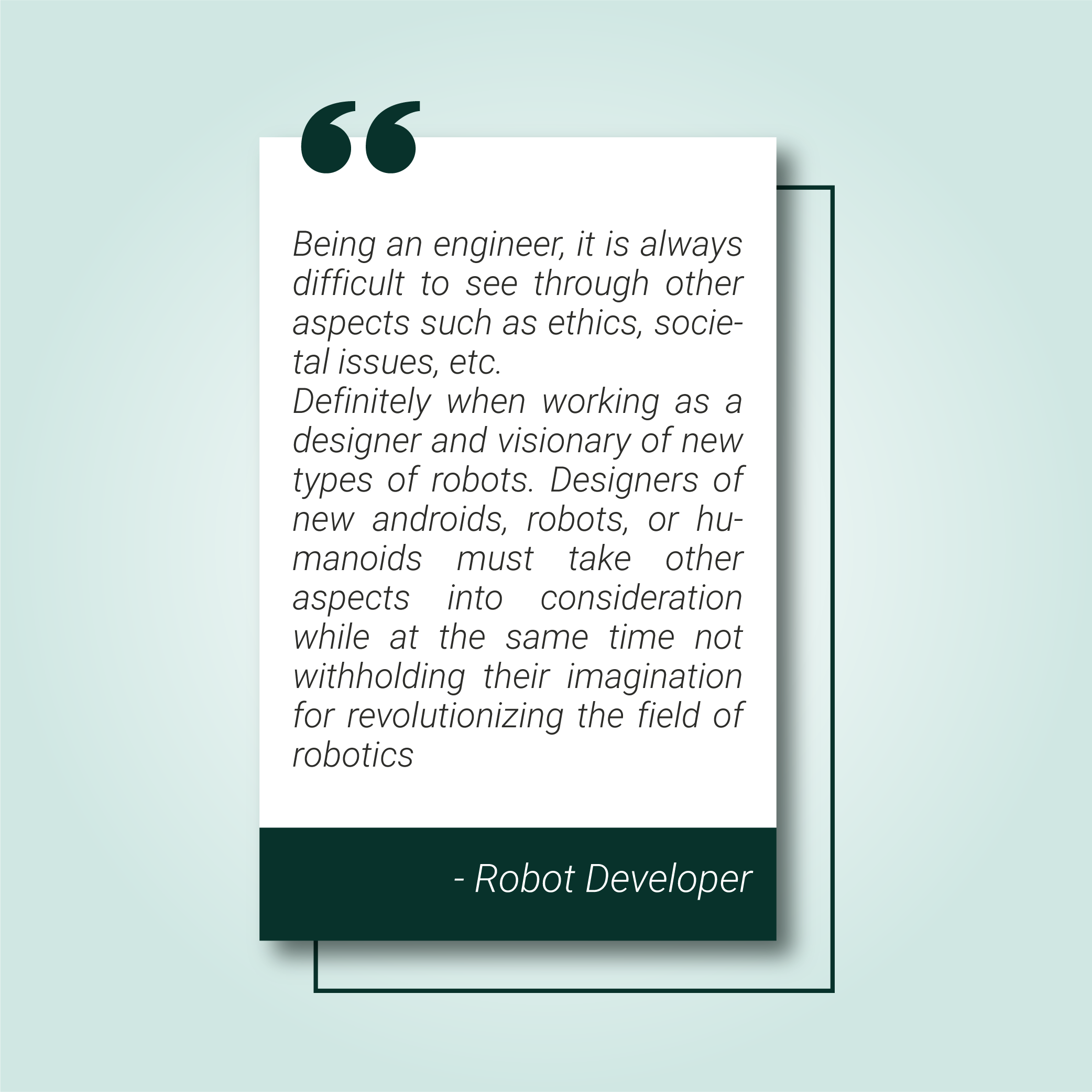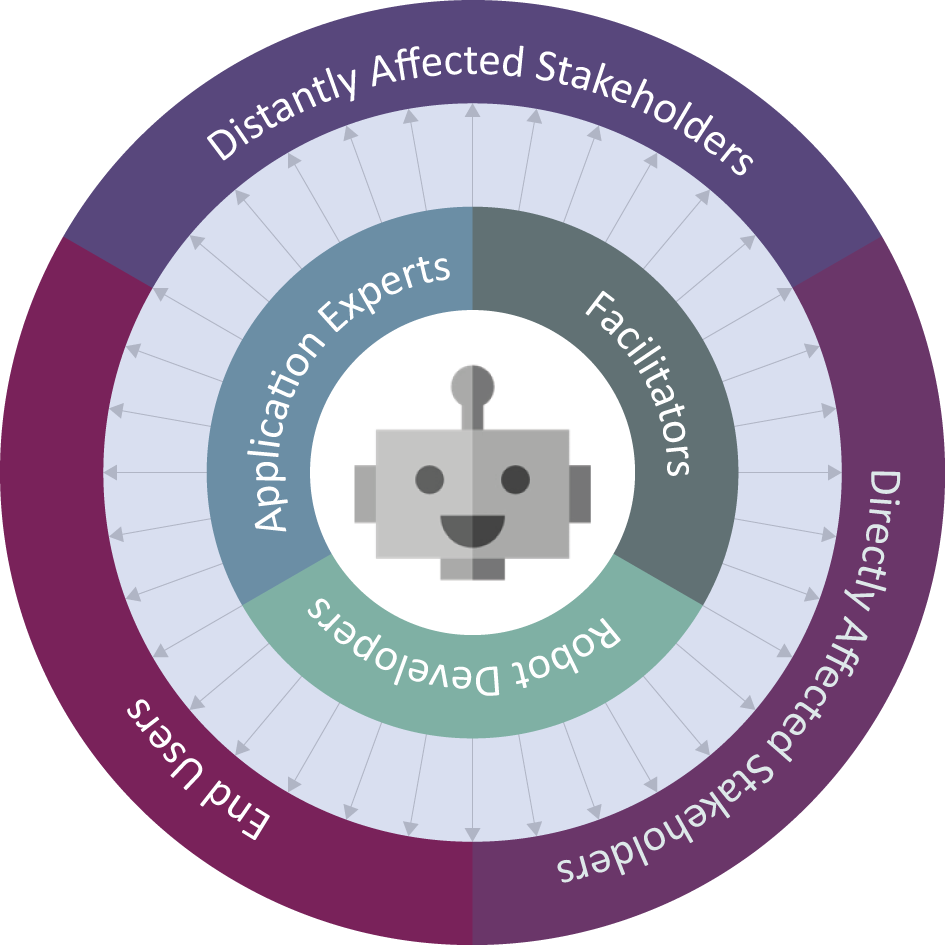Human Proximity
How to better align different perspectives?

There is a range of ethical issues emerging from a disconnect between the robot makers responsible for the development of new robots and the affected stakeholders whose lives will be changed by their introduction into the world. This disconnect, or proximity gap, entails a physical distance between robot makers and affected stakeholders, but also differences in understandings, values, or motives.
It is important to identify the proximity gaps specific to particular robot makers and those stakeholders affected by their robots, and to close these situation-specific gaps in seeking alignment.


Human Proximity Model
There is a gap between robot makers and affected stakeholders due to their different sociomaterial worlds and separate core expertises.
.
Increasing Human Proximity and Identifying Motives
It can be challenging for robot makers to address the proximity gaps on their own. There are many structural and social issues that make it difficult for them to collaborate directly with end-users and affected stakeholders. Some of them are described here:
It is very consuming (and thus expensive) to collaborate with people with whom you do not share common language or motives. It takes time to recruit participants, to help them understand the proposed project, and to become familiar with their everyday work.
Robot development is often distributed, both geographically and in terms of tasks. One person or organization might be responsible for developing the user interface while another works on movement and navigation. It is unclear who should be responsible for collaborating with the end-user and affected stakeholders.
Legal/Regulatory and practical limitations may also impede access to real-sites during development. Many safety and occupational hazard regulations inhibit testing of prototypes in workplace settings.
Sometimes, the involvement of end-users may precipitate changes which complicate the development process. If and end-user's experiences disrupt the normative perception of use/users, they may necessitate costly or time-consuming changes to the robot's design.
Robot makers often do not recognize affected stakeholders as relevant to the development process. Even the end-users that they do identify are often used instrumentally as testers as it can be difficult to step outside one's own experiences to recognize the potential contributions that end-users and affected stakeholders can offer.
Even if robot makers do engage with end-users and more distantly affected stakeholders, it can be difficult to find out what matters to them. Without sufficient relational expertise, collaboration remains cooperation withouth any alignment of motives.
Alignment Experts might be capable of doing this bridging work for the robot developers and affected stakeholders. This alignment task would involve spanning the space between the robotic bubble and the affected stakeholders’ communities to identify their separate motives, and to communicate them to one another in a move toward alignment and collaborative learning.

- Proximity Gap: Physical and conceptual distance between persons, including differences in understandings, values, or motives.
- Collaborative Learning: A process of alignment of different motives and expectations in working toward a common goal.
- Alignment Experts: Intermediaries working to align robot makers' and affected stakeholders' motives, based on empirical knowledge of both.
- Core Expertise: The skillset and knowledge base one has developed through education and/or experience.
- Relational Expertise: A capacity to recognize the motives of those with different core expertises, to understand the value of their expertise, and to mutually align motives in joint work.
- Cultural Brokerage: Translating motives, values, and understandings between persons with different cultures and disciplines to increase human proximity and promote relational expertise.
- Common Language: A common ground of mutual understanding, knowledge, beliefs, assumptions, pre-suppositions, etc.
Key Concepts
Reflection Points
- Where in the design and development process would you collaborate with Alignment Experts?
- What structural and social issues do you think you will face when collaborating with Alignment Experts?
- Collaboration with Alignment Experts should be distributed? Why?
- From what you have seen in the REELER project, do you think is possible to create a common language with Alignment Experts? Why?
Concluding Remarks on Human Proximity
Collaborative learning was chosen as a key concept for the REELER project because our main hypothesis was that robot makers need new tools to improve their knowledge of and collaboration with users and affected stakeholders, in order to improve the creation of responsible and ethical robotics in Europe. This is partly due to the robots coming out of their protective cages in industrial settings and directly engaging with people in their everyday lives, partly because robots (combined with AI) are changing the lives and work for most of the European population with the present development of robotics in new fields.
Also, the robot makers themselves begin to see the need to expand their collaborations and raise their awareness. We acknowledge that it is probably not possible to work directly with the most distantly affected stakeholders, but we will carefully suggest that robot makers and robots can benefit (in terms of ethics and market value) when these collaborations occur. Collaboration is a process where you develop something together – and collaborative learning is, in REELER’s definition, a matter of aligning motives. REELER proposes a holistic approach to robot ethics that centers on collaboration across the Human Proximity Model, facilitated by alignment experts.
If you found this interesting, read more here:
Click here to Download Chapter 12: Human Proximity
Download
If you enjoyed reading about Human Proximity, you may also like:
By going over each icon with the mouse you will get a brief description of the corresponding topic.